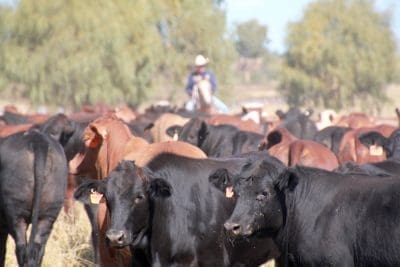BUYING and selling slaughter cattle through direct consignment is not like ‘trading lumps of wood’, processors who do not support public disclosure of grid prices suggested this morning.
Beef Central approached large multi-site beef processors Teys Australia, JBS and NH Foods for a response after competitor Thomas Foods International announced yesterday that it will join NSW processor, Bindaree Beef in publicly disclosing current grids via its website (see today’s separate story).
 Bindaree’s and TFI’s decisions follow recommendations made by the Australian Competition and Consumer Commission last year as part of its Beef Market Study, that to improve transparency and industry efficiency, cattle buyers using price grids should make them publicly available to producers in a timely manner.
Bindaree’s and TFI’s decisions follow recommendations made by the Australian Competition and Consumer Commission last year as part of its Beef Market Study, that to improve transparency and industry efficiency, cattle buyers using price grids should make them publicly available to producers in a timely manner.
The study’s final report recommended that grids should be published in a prominent position on a processor’s website and also be made available through an unconditional phone request as soon as practicable after prices are updated.
While TFI and Bindaree now follow that recommendation, other processors say there are compelling reasons why they have chosen not to post current grid offers on their websites.
Much of that was to do with the relationship and critical need for direct communication between livestock buyer and seller, they said.
Just one of the reasons raised was the risk that producers might not adequately understand or appreciate the differences that existed between one company’s grid offer and another – that could have significant impact on the ultimate price achieved. Weight and fatness tolerances were good examples, one processor pointed out.
Testimony delivered by AusMeat CEO Ian King and others during the ACCC and Senate inquiries last year clearly flagged the lack of understanding among some beef producers about how price grids worked. That process led to a producer education program being implemented, to start to address the problem, including this webinar hosted by Beef Central, which attracted almost 500 stakeholders.
Teys Australia managing director Brad Teys, said one of the biggest issues with simply posting grids online was that it reduced the opportunity for the company livestock buyer to directly ‘engage’ with the prospective supplier in a meaningful way.
“It’s all about relationships. We want to talk directly with our prospective suppliers, and we feel simply posting grids online would damage that opportunity,” he said.
“It’s never going to be like buying a set of dumb-bells or an exercise bike on Amazon or eBay. Beef is a relationship-based industry, and having that first-hand engagement is vital,” he said.
There were times when grids could change two or three times in a day – both upwards and downwards, Mr Teys said.
“When the market is going backwards like this due to over-supply, if major competitors were compelled to post their grids as they changed – perhaps hourly – it would be very easy for other stakeholders to draw the conclusion that competitors were price-signalling to each other,” he said.
“If you wanted to introduce a mechanism that allows processor competitors to easily signal price movements to each other – mandatory public grids would certainly do that,” he said.
Nor did it address the tendency for many processors to offer ‘plus-five’ or ‘plus-ten’ on top of the nominated grid offers, at certain times in the supply-demand cycle.
Mr Teys said his company remained ‘neutral’ on the issue of publicly-accessible grids, and if pushed by the ACCC to implement it, would probably do it. But he stressed that he saw serious negative implications for the industry, particularly when cattle prices were in decline.
“Under such circumstances, some producers would very quickly accuse us of price signalling –following each other all the way down.”
He said the relationship between producer and processor relied heavily on communication.
“We really need to engage with producers in a meaningful way when trading over the hooks. Every transaction is a negotiation, especially when cattle turn-off tightens. Buyers have to be talking directly to their producer contacts – relationships and intuition will always matter in this area.”
“Cattle aren’t like that – they’re all different; the seasons differ from year to year; the turnoff this year might be later than last year – all these things have to be considered in the transaction, and that requires direct communication.”
General manager of NH Foods’ Oakey Holdings, which runs large export abattoirs at Mackay and Oakey in Queensland and Wingham in NSW, Pat Gleeson said his company chose not to publish grids, because the downsides clearly outweighed any advantages perceived by the ACCC.
“Ours is a relationships- based business, with a strong level of trust,” Mr Gleeson said.
“There’s often differences between how our grids are set up and others, that producers could easily overlook or misinterpret, without having that discussion,” he said.
“Those phone discussions between buyer and seller add a lot of context – providing a sense of what cattle he or she has coming through the system, or whether he has cattle available, if a hole needs to be filled in a kill. All that gets lost if today’s price is simply posted on a website somewhere. We need our valued suppliers to continue to talk to us.”
“Sanitising the process and treating slaughter cattle like a commodity would destroy that vital communication,” Mr Gleeson said.



Having public grids is progress towards a more mature, efficient and transparent market. If grid prices for our cattle fluctuate we should be able to see the changes in real time online. This would far outweigh any perceived disadvantage for the potential for price signalling. The vast majority of producers are also smart enough to understand the broad differences in grading, and we can always ask the buyer if we need guidance. Hopefully Teys, JBS and NH start publishing their grids publically on their websites, driving the industry into the 21st century.
Brad and Pat are right – buying cattle has to be a relationship based process. However, producers need to understand what is being offered by the market for their class of stock. We regularly turned off feeder steers to JBS Tabbita having established a relationship with their buyers and their knowing our steers dressed well. We never had a problem placing them even in the difficult periods.
Producers usually only have one or two choices for their finished product as distance to market is a limiting factor. This of course varies across Australia’s beef regions. Processors do form buying groups where they share volume and do follow each other all the way down. This issue was raised with ACCC commissioner Mike Keogh in Albury at the launch meeting of Cattle Producers Australia. Often in saleyards agents will act on both sides of the buying transaction representing the vendor but also buying in many cases as purchaser on their account to hold for another day. Mick Keogh is right, these matters need to be fixed so the party with the least power these transactions, the cattle producer, can rely on an improved marketplace where knowledge is shared equally between all parties competing for livestock.
Perhaps the only answer is mandatory public grids for the sale of weight and grade cattle for slaughter. While we are discussing this difficult area of policy, we also need to have full reporting of cattle sales to a central bureau who publish daily sales of livestock by description as happens in the USA. In their market we can explore graphs showing short and long term trends for the sale of all types of cattle. Seasonal fluctuations are compared to see where the producer is in the cyclical movement of cattle sales. This information is needed for our producers here in Australia and reported by cattle region.
So sales of livestock are relationship based, but this does not counter the need for the information outlined by the ACCC report including the publishing of the price grids offered by each processor. Congratulations to Bindaree Beef and TFI for leading this change. I am sure they will not lose clients to Teys in Naracoorte and JBS at Scone and Dinmore as they battle for their daily kills.